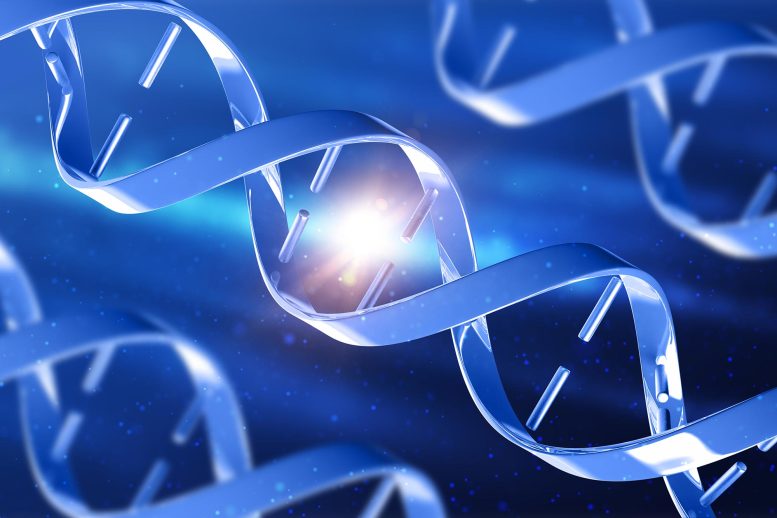
A groundbreaking study has unveiled key genes linked to DNA damage, offering new perspectives on cancer, neurodegenerative diseases, and potential therapies. This research underscores the significance of maintaining genome stability for health and disease management.
Scientists unveil 145 genes vital for genome health, and possible strategies to curb progression of human genomic disorders.
More than one hundred key genes linked to DNA damage have been uncovered through systematic screening of nearly 1,000 genetically modified mouse lines, in a new study published on February 14 in the journal Nature.
The work provides insights into cancer progression and neurodegenerative diseases as well as a potential therapeutic avenue in the form of a protein inhibitor.
The genome contains all the genes and genetic material within an organism’s cells. When the genome is stable, cells can accurately replicate and divide, passing on correct genetic information to the next generation of cells. Despite its significance, little is understood about the genetic factors governing genome stability, protection, repair, and the prevention of DNA damage.[1]
Groundbreaking Research and Its Implications
In this new study, researchers from the Wellcome Sanger Institute, and their collaborators at the UK Dementia Research Institute at the University of Cambridge, set out to better understand the biology of cellular health and identify genes key to maintaining genome stability.
Using a set of genetically modified mouse lines, the team identified 145 genes that play key roles in either increasing or decreasing the formation of abnormal micronuclei structures.[2] These structures indicate genomic instability and DNA damage, and are common hallmarks of aging and diseases.
The most dramatic increases in genomic instability were seen when the researchers knocked out the gene DSCC1, increasing abnormal micronuclei formation five-fold. Mice lacking this gene mirrored characteristics akin to human patients with cohesinopathy disorders,[3] further emphasizing the relevance of this research to human health.
Using CRISPR screening, researchers showed this effect triggered by DSCC1 loss could be partially reversed through inhibiting protein SIRT1.[4] This offers a highly promising avenue for the development of new therapies.
Promising Avenues for Therapy
The findings help shed light on genetic factors influencing the health of human genomes over a lifespan and disease development.
Professor Gabriel Balmus, senior author of the study at the UK Dementia Research Institute at the University of Cambridge, formerly at the Wellcome Sanger Institute, said: “Continued exploration on genomic instability is vital to develop tailored treatments that tackle the root genetic causes, with the goal of improving outcomes and the overall quality of life for individuals across various conditions. Our study underscores the potential of SIRT inhibitors as a therapeutic pathway for cohesinopathies and other genomic disorders. It suggests that early intervention, specifically targeting SIRT1, could help mitigate the biological changes linked to genomic instability before they progress.”
Dr David Adams, first author of the study at the Wellcome Sanger Institute, said: “Genomic stability is central to the health of cells, influencing a spectrum of diseases from cancer to neurodegeneration, yet this has been a relatively underexplored area of research. This work, of 15 years in the making, exemplifies what can be learned from large-scale, unbiased genetic screening. The 145 identified genes, especially those tied to human disease, offer promising targets for developing new therapies for genome instability-driven diseases like cancer and neurodevelopmental disorders.”
Notes
- Various sources of damage to the genome can include radiation, chemical exposure, and errors during DNA replication or repair processes.
- Micronuclei are small abnormal structures, often referred to as “mutation factories”, containing misplaced genetic material, that should otherwise be in the cell nucleus. Their presence signifies an increased risk of diseases like cancer and developmental disorders.
- Cohesinopathy disorders are a group of genetic conditions resulting from dysfunctional cohesin proteins, essential for proper chromosome organisation and segregation during cell division. This can lead to a spectrum of developmental abnormalities, intellectual disability, distinctive facial features and growth retardation.
- When the SIRT1 protein was suppressed, DNA damage reduced and they could rescue the negative effects of DSCC1 loss associated with cohesion disruption. This action was via restoring chemical levels of a protein called SMC3.
Reference: “Genetic determinants of micronucleus formation in vivo” by D. J. Adams, B. Barlas, R. E. McIntyre, I. Salguero, L. van der Weyden, A. Barros, J. R. Vicente, N. Karimpour, A. Haider, M. Ranzani, G. Turner, N. A. Thompson, V. Harle, R. Olvera-León, C. D. Robles-Espinoza, A. O. Speak, N. Geisler, W. J. Weninger, S. H. Geyer, J. Hewinson, N. A. Karp, The Sanger Mouse Genetics Project, B. Fu, F. Yang, Z. Kozik, J. Choudhary, L. Yu, M. S. van Ruiten, B. D. Rowland, C. J. Lelliott, M. del Castillo Velasco-Herrera, R. Verstraten, L. Bruckner, A. G. Henssen, M. A. Rooimans, J. de Lange, T. J. Mohun, M. J. Arends, K. A. Kentistou, P. A. Coelho, Y. Zhao, H. Zecchini, J. R. B. Perry, S. P. Jackson and G. Balmus, 14 February 2024, Nature.
DOI: 10.1038/s41586-023-07009-0









This article makes it sound like we have no understanding of DNA repair systems. That is far from true.
And, in general, it would likely be a very bad thing to suppress SERT1.
Also, mice have very poor defenses against cancer. Not exactly the ideal subjects, if we want what we learn to be applicable to humans. We have pretty good defenses.
Also, it is not just toxins and radiation, but also pathogens (usually viruses), and quantum tunneling where heat quanta, by chance, converge locally increasing the heat providing energy for reactions that are destructive. The higher the body temperature, the higher the probability of these events, which is why body temperature is a substantial factor in species lifespan. We are stuck at our body temperature because our enzymes require a tight temperature range. Cooling down mice, using a genetic modification, by just 0.5 degrees, extended their lives 10-20%. The likely reason bowhead whales live over 200 years is because they have a cooler body temperature. Naked mole rats live ten times longer than similar animals because they are effectively cold-blooded.
Radiation damage is interesting too. We think of uranium, and radon, but there is radiation from outer space that reaches us, and a couple elements we ingest that we need to survive are radioactive. Potassium is absolutely critical to life, but one isotope in it is radioactive (Potassium 40). Similarly, there is carbon 14 in virtually everything we eat.
More useful for extending lives in general, in my opinion, is studying what makes some people live past 100, past 105, and beyond. And really investigating how we can duplicate those advantages. Though it is not an either-or and work is being done that way. The research they did may help children with major genetic defects…so that is great too.